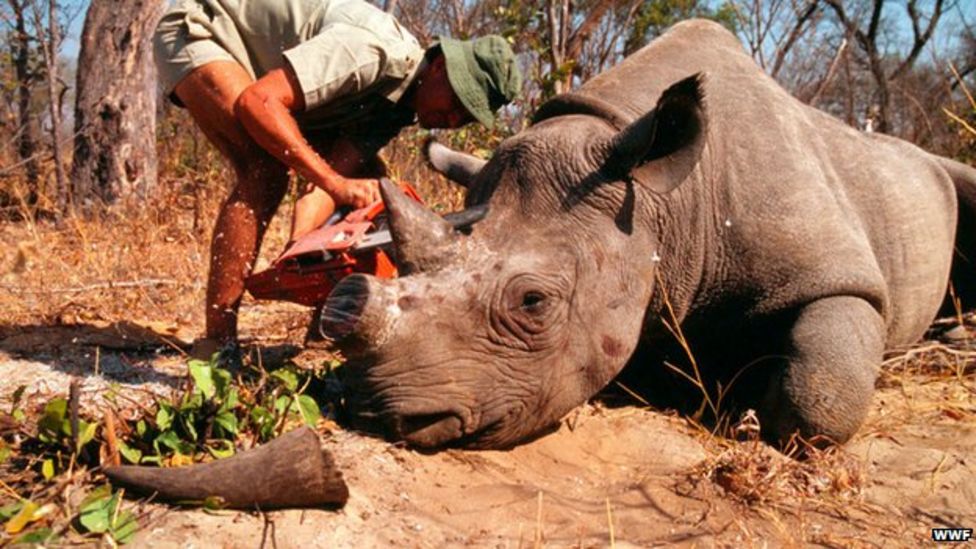Poaching
“
— ”
The illegal hunting and trafficking of animals, or poaching, has plagued South Africa since colonial times. From its earliest days, poaching was primarily for sport and trophy hunting, with little regard for wildlife population sustainability. By the early twentieth century, for instance, the rhinoceros population within South Africa numbered less than two-hundred adults.1 Rhinoceroses, alongside elephants, have been particularly targeted by South African poaching for their horns.
To combat this crisis, state-backed nature and game reserves were established to nurture several animal populations back to sustainable levels. Though these reserves have helped to replenish the population of rhinoceroses, they have been insufficient to prevent poaching. In the 1970s and 1980s, for instance, growing demand from burgeoning markets in Southeast Asia for pulverized rhinoceros horns as traditional Chinese herbal medicine once again drove poaching to decimate ninety-six percent of the South African rhinoceros population.2 In 2021, rhinoceros poaching numbers had increased for the first time since 2014 when a record number had been killed.3
While private game reserves in South Africa will have their own security teams patrolling smaller parks, the larger public parks, such as Kruger National Park, are inherently more difficult to monitor wildlife in, patrol, and prevent poachers from breaching into – poachers who are often South African, or nationals from neighboring countries like Mozambique or Botswana, but all funded by criminal organizations from Asia.
In addition to the deployment of park rangers by state-operated foundations, non-governmental organizations have gradually taken a larger role in anti-poaching measures, including the patrolling of parks, or the facilitation of crowd-funding anti-poaching funds from the international community. Similarly, anti-poaching techniques have diversified beyond patrol, “broken-windows” deterrence, and boots-on-the-ground surveillance: horn removal and poisoning techniques have been developed to disincentivize the needless killing of the animals, while remote surveillance techniques using unmanned drones and thermal cameras have been deployed, particularly as a supplement to deter illegal passage across the South Africa-Mozambique border along Kruger National Park.

Image source: “Rhino Poaching in South Africa Reaches Record Levels,” BBC News, January 10, 2013, sec. Science & Environment, https://www.bbc.com/news/science-environment-20971182.
References
1. “Rhinoceros Poaching in Southern Africa,” in Wikipedia, January 29, 2022, https://en.wikipedia.org/w/index.php?title=Rhinoceros_poaching_in_Southern_Africa&oldid=1068621568.
2. “African Rhinos,” accessed February 28, 2022, https://wwf.panda.org/discover/knowledge_hub/endangered_species/rhinoceros/african_rhinos.cfm.
3. “Rhino Poaching in South Africa Rises for First Time in 7 Years,” Bloomberg.Com, February 9, 2022, https://www.bloomberg.com/news/articles/2022-02-09/rhino-poaching-in-south-africa-increases-as-covid-19-curbs-ease.
1. “Rhinoceros Poaching in Southern Africa,” in Wikipedia, January 29, 2022, https://en.wikipedia.org/w/index.php?title=Rhinoceros_poaching_in_Southern_Africa&oldid=1068621568.
2. “African Rhinos,” accessed February 28, 2022, https://wwf.panda.org/discover/knowledge_hub/endangered_species/rhinoceros/african_rhinos.cfm.
3. “Rhino Poaching in South Africa Rises for First Time in 7 Years,” Bloomberg.Com, February 9, 2022, https://www.bloomberg.com/news/articles/2022-02-09/rhino-poaching-in-south-africa-increases-as-covid-19-curbs-ease.